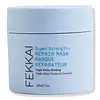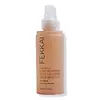What's inside
What's inside
 Key Ingredients
Key Ingredients

 Benefits
Benefits

 Concerns
Concerns

 Ingredients Side-by-side
Ingredients Side-by-side

Water
Skin ConditioningCetearyl Alcohol
EmollientCetyl Esters
EmollientHelianthus Annuus Seed Extract
Skin ConditioningSimmondsia Chinensis Seed Oil
EmollientPanthenol
Skin ConditioningTocopherol
AntioxidantGlycerin
HumectantGlycine
BufferingAlanine
MaskingSerine
MaskingValine
MaskingIsoleucine
Skin ConditioningProline
Skin ConditioningThreonine
Histidine
HumectantArginine
MaskingPhenylalanine
MaskingAminomethyl Propanol
BufferingButylene Glycol
HumectantDisodium PEG-12 Dimethicone Sulfosuccinate
CleansingPCA Dimethicone
Skin ConditioningAspartic Acid
MaskingPCA
HumectantSodium PCA
HumectantCetyl Alcohol
EmollientStearamidopropyl Dimethylamine
EmulsifyingHydroxyethylcellulose
Emulsion StabilisingQuaternium-91
Myristyl Myristate
EmollientBehentrimonium Chloride
PreservativeCetrimonium Chloride
AntimicrobialTrimethylsiloxyamodimethicone
C12-16 Pareth-9
EmulsifyingTrideceth-12
EmulsifyingC11-15 Pareth-7
EmulsifyingIsopropyl Alcohol
SolventEthylhexylglycerin
Skin ConditioningCitric Acid
BufferingTetrasodium EDTA
Polysorbate 60
EmulsifyingDisodium Phosphate
BufferingSodium Phosphate
BufferingSodium Lactate
BufferingSodium Benzoate
MaskingPhenoxyethanol
PreservativeParfum
MaskingCoumarin
PerfumingWater, Cetearyl Alcohol, Cetyl Esters, Helianthus Annuus Seed Extract, Simmondsia Chinensis Seed Oil, Panthenol, Tocopherol, Glycerin, Glycine, Alanine, Serine, Valine, Isoleucine, Proline, Threonine, Histidine, Arginine, Phenylalanine, Aminomethyl Propanol, Butylene Glycol, Disodium PEG-12 Dimethicone Sulfosuccinate, PCA Dimethicone, Aspartic Acid, PCA, Sodium PCA, Cetyl Alcohol, Stearamidopropyl Dimethylamine, Hydroxyethylcellulose, Quaternium-91, Myristyl Myristate, Behentrimonium Chloride, Cetrimonium Chloride, Trimethylsiloxyamodimethicone, C12-16 Pareth-9, Trideceth-12, C11-15 Pareth-7, Isopropyl Alcohol, Ethylhexylglycerin, Citric Acid, Tetrasodium EDTA, Polysorbate 60, Disodium Phosphate, Sodium Phosphate, Sodium Lactate, Sodium Benzoate, Phenoxyethanol, Parfum, Coumarin
Water
Skin ConditioningHeptyl Glucoside
Pentylene Glycol
Skin ConditioningPropanediol
SolventPhenoxyethanol
PreservativeButyrospermum Parkii Butter
Skin ConditioningShea Butter Glycereth-8 Esters
CleansingCocos Nucifera Oil
MaskingOryza Sativa Seed Protein
AntioxidantGlycerin
HumectantPanthenol
Skin ConditioningHydrolyzed Vegetable Protein
Skin ConditioningGardenia Taitensis Flower Extract
Skin ConditioningOryza Sativa Extract
AbsorbentCalodendrum Capense Nut Oil
EmollientOpuntia Ficus-Indica Seed Oil
EmollientCamellia Sinensis Leaf Extract
AntimicrobialLeuconostoc/Radish Root Ferment Filtrate
AntimicrobialCaesalpinia Spinosa Fruit Extract
Skin ProtectingHelianthus Annuus Sprout Extract
Skin ConditioningLactobacillus/Eriodictyon Californicum Ferment Extract
Skin ConditioningLeontopodium Alpinum Extract
Skin ConditioningLithothamnion Calcareum Extract
Skin ConditioningSalvia Hispanica Seed Extract
EmollientNasturtium Officinale Extract
PerfumingTrehalose
HumectantAmylopectin
Gluconolactone
Skin ConditioningHydroxypropyl Guar Hydroxypropyltrimonium Chloride
Biotin
AntiseborrhoeicCalcium Gluconate
HumectantSalicylic Acid
MaskingSorbitan Oleate
EmulsifyingTetrasodium Glutamate Diacetate
Tocopherol
AntioxidantXanthan Gum
EmulsifyingGalactoarabinan
Ethyl Oleate
EmollientParfum
MaskingMaltodextrin
AbsorbentPentaerythrityl Tetra-Di-T-Butyl Hydroxyhydrocinnamate
AntioxidantBenzyl Alcohol
PerfumingCaprylyl/Capryl Glucoside
CleansingCetrimonium Chloride
AntimicrobialIsopropyl Myristate
EmollientLactic Acid
BufferingDipropylene Glycol
HumectantEthyl Linoleate
EmollientLimonene
PerfumingLinalool
PerfumingCaprylic Acid
CleansingPotassium Hydroxide
BufferingPotassium Sorbate
PreservativeSodium Benzoate
MaskingCitric Acid
BufferingCoumarin
PerfumingSodium Glycolate
BufferingSodium Hydroxide
BufferingXylitol
HumectantPhospholipids
Skin ConditioningSodium Formate
BufferingSodium Phosphate
BufferingCaprylyl Glycol
EmollientChlorphenesin
AntimicrobialPhytic Acid
Polyquaternium-37
Water, Heptyl Glucoside, Pentylene Glycol, Propanediol, Phenoxyethanol, Butyrospermum Parkii Butter, Shea Butter Glycereth-8 Esters, Cocos Nucifera Oil, Oryza Sativa Seed Protein, Glycerin, Panthenol, Hydrolyzed Vegetable Protein, Gardenia Taitensis Flower Extract, Oryza Sativa Extract, Calodendrum Capense Nut Oil, Opuntia Ficus-Indica Seed Oil, Camellia Sinensis Leaf Extract, Leuconostoc/Radish Root Ferment Filtrate, Caesalpinia Spinosa Fruit Extract, Helianthus Annuus Sprout Extract, Lactobacillus/Eriodictyon Californicum Ferment Extract, Leontopodium Alpinum Extract, Lithothamnion Calcareum Extract, Salvia Hispanica Seed Extract, Nasturtium Officinale Extract, Trehalose, Amylopectin, Gluconolactone, Hydroxypropyl Guar Hydroxypropyltrimonium Chloride, Biotin, Calcium Gluconate, Salicylic Acid, Sorbitan Oleate, Tetrasodium Glutamate Diacetate, Tocopherol, Xanthan Gum, Galactoarabinan, Ethyl Oleate, Parfum, Maltodextrin, Pentaerythrityl Tetra-Di-T-Butyl Hydroxyhydrocinnamate, Benzyl Alcohol, Caprylyl/Capryl Glucoside, Cetrimonium Chloride, Isopropyl Myristate, Lactic Acid, Dipropylene Glycol, Ethyl Linoleate, Limonene, Linalool, Caprylic Acid, Potassium Hydroxide, Potassium Sorbate, Sodium Benzoate, Citric Acid, Coumarin, Sodium Glycolate, Sodium Hydroxide, Xylitol, Phospholipids, Sodium Formate, Sodium Phosphate, Caprylyl Glycol, Chlorphenesin, Phytic Acid, Polyquaternium-37
Ingredients Explained
These ingredients are found in both products.
Ingredients higher up in an ingredient list are typically present in a larger amount.
This ingredient is a preservative, antimicrobial, and emulsifier. It is often used in cosmetics for its ability to cleanse, condition, and reduce static.
Cetrimonium chloride is a quaternary ammonium salt, meaning it has a water-soluble structure.
Citric Acid is an alpha hydroxy acid (AHA) naturally found in citrus fruits like oranges, lemons, and limes.
Like other AHAs, citric acid can exfoliate skin by breaking down the bonds that hold dead skin cells together. This helps reveal smoother and brighter skin underneath.
However, this exfoliating effect only happens at high concentrations (20%) which can be hard to find in cosmetic products.
Due to this, citric acid is usually included in small amounts as a pH adjuster. This helps keep products slightly more acidic and compatible with skin's natural pH.
In skincare formulas, citric acid can:
While it can provide some skin benefits, research shows lactic acid and glycolic acid are generally more effective and less irritating exfoliants.
Most citric acid used in skincare today is made by fermenting sugars (usually from molasses). This synthetic version is identical to the natural citrus form but easier to stabilize and use in formulations.
Read more about some other popular AHA's here:
Learn more about Citric AcidCoumarins are a group of substances found naturally in plants. There are over 1300 types of coumarins identified. It has a natural vanilla scent.
Coumarin is an identified EU known allergy, meaning it may cause an allergic reaction when applied to the skin.
In many countries, coumarin is banned as a food additive. However, it can be found in soaps, tobacco products, and some alcohol drinks.
Plants use coumarins as a chemical defense. Some plants that have coumarins include lavender, tonka beans, and yellow clovers.
Learn more about CoumarinGlycerin is already naturally found in your skin. It helps moisturize and protect your skin.
A study from 2016 found glycerin to be more effective as a humectant than AHAs and hyaluronic acid.
As a humectant, it helps the skin stay hydrated by pulling moisture to your skin. The low molecular weight of glycerin allows it to pull moisture into the deeper layers of your skin.
Hydrated skin improves your skin barrier; Your skin barrier helps protect against irritants and bacteria.
Glycerin has also been found to have antimicrobial and antiviral properties. Due to these properties, glycerin is often used in wound and burn treatments.
In cosmetics, glycerin is usually derived from plants such as soybean or palm. However, it can also be sourced from animals, such as tallow or animal fat.
This ingredient is organic, colorless, odorless, and non-toxic.
Glycerin is the name for this ingredient in American English. British English uses Glycerol/Glycerine.
Learn more about GlycerinPanthenol is a common ingredient that helps hydrate and soothe the skin. It is found naturally in our skin and hair.
There are two forms of panthenol: D and L.
D-panthenol is also known as dexpanthenol. Most cosmetics use dexpanthenol or a mixture of D and L-panthenol.
Panthenol is famous due to its ability to go deeper into the skin's layers. Using this ingredient has numerous pros (and no cons):
Like hyaluronic acid, panthenol is a humectant. Humectants are able to bind and hold large amounts of water to keep skin hydrated.
This ingredient works well for wound healing. It works by increasing tissue in the wound and helps close open wounds.
Once oxidized, panthenol converts to pantothenic acid. Panthothenic acid is found in all living cells.
This ingredient is also referred to as pro-vitamin B5.
Learn more about PanthenolParfum is a catch-all term for an ingredient or more that is used to give a scent to products.
Also called "fragrance", this ingredient can be a blend of hundreds of chemicals or plant oils. This means every product with "fragrance" or "parfum" in the ingredients list is a different mixture.
For instance, Habanolide is a proprietary trade name for a specific aroma chemical. When used as a fragrance ingredient in cosmetics, most aroma chemicals fall under the broad labeling category of “FRAGRANCE” or “PARFUM” according to EU and US regulations.
The term 'parfum' or 'fragrance' is not regulated in many countries. In many cases, it is up to the brand to define this term.
For instance, many brands choose to label themselves as "fragrance-free" because they are not using synthetic fragrances. However, their products may still contain ingredients such as essential oils that are considered a fragrance by INCI standards.
One example is Calendula flower extract. Calendula is an essential oil that still imparts a scent or 'fragrance'.
Depending on the blend, the ingredients in the mixture can cause allergies and sensitivities on the skin. Some ingredients that are known EU allergens include linalool and citronellol.
Parfum can also be used to mask or cover an unpleasant scent.
The bottom line is: not all fragrances/parfum/ingredients are created equally. If you are worried about fragrances, we recommend taking a closer look at an ingredient. And of course, we always recommend speaking with a professional.
Learn more about ParfumPhenoxyethanol is a preservative that has germicide, antimicrobial, and aromatic properties. Studies show that phenoxyethanol can prevent microbial growth. By itself, it has a scent that is similar to that of a rose.
It's often used in formulations along with Caprylyl Glycol to preserve the shelf life of products.
Sodium Benzoate is a preservative. It's used in both cosmetic and food products to inhibit the growth of mold and bacteria. It is typically produced synthetically.
Both the US FDA and EU Health Committee have approved the use of sodium benzoate. In the US, levels of 0.1% (of the total product) are allowed.
Sodium benzoate works as a preservative by inhibiting the growth of bacteria inside of cells. It prevents the cell from fermenting a type of sugar using an enzyme called phosphofructokinase.
It is the salt of benzoic acid. Foods containing sodium benzoate include soda, salad dressings, condiments, fruit juices, wines, and snack foods.
Studies for using ascorbic acid and sodium benzoate in cosmetics are lacking, especially in skincare routines with multiple steps.
We always recommend speaking with a professional, such as a dermatologist, if you have any concerns.
Learn more about Sodium BenzoateSodium phosphate is a group of inorganic sodium salts (mono, di, and tri-sodium phosphate). It has pH buffering, chelating, and stabilizing properties.
This means it helps maintain a formula's acidity, enhances preservative performance, and prevents unwanted changes caused by metal ions or hard water.
Sodium phosphate is considered safe for use in cosmetics according to the Cosmetic Ingredient Review (CIR); it also has a long-established food-grade safety rating as well.
Though some sources claim sodium phosphate can help "energize skin cells", this claim is not strongly supported by independent scientific studies.
Learn more about Sodium PhosphateTocopherol (also known as Vitamin E) is a common antioxidant used to help protect the skin from free-radicals and strengthen the skin barrier. It's also fat soluble - this means our skin is great at absorbing it.
Vitamin E also helps keep your natural skin lipids healthy. Your lipid skin barrier naturally consists of lipids, ceramides, and fatty acids. Vitamin E offers extra protection for your skin’s lipid barrier, keeping your skin healthy and nourished.
Another benefit is a bit of UV protection. Vitamin E helps reduce the damage caused by UVB rays. (It should not replace your sunscreen). Combining it with Vitamin C can decrease sunburned cells and hyperpigmentation after UV exposure.
You might have noticed Vitamin E + C often paired together. This is because it is great at stabilizing Vitamin C. Using the two together helps increase the effectiveness of both ingredients.
There are often claims that Vitamin E can reduce/prevent scarring, but these claims haven't been confirmed by scientific research.
Learn more about TocopherolWater. It's the most common cosmetic ingredient of all. You'll usually see it at the top of ingredient lists, meaning that it makes up the largest part of the product.
So why is it so popular? Water most often acts as a solvent - this means that it helps dissolve other ingredients into the formulation.
You'll also recognize water as that liquid we all need to stay alive. If you see this, drink a glass of water. Stay hydrated!
Learn more about Water